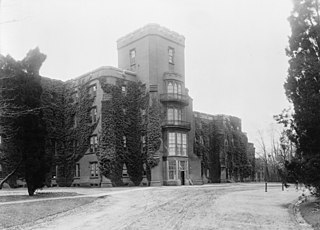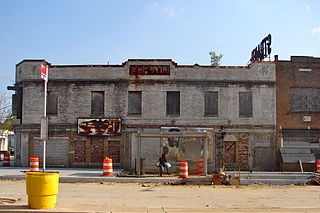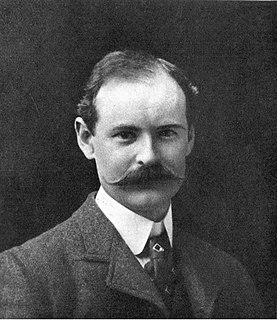
St. Elizabeths Hospital is a psychiatric hospital in Southeast, Washington, D.C. operated by the District of Columbia Department of Behavioral Health. It opened in 1855 with the name Government Hospital for the Insane, the first federally operated psychiatric hospital in the United States. Housing over 8,000 patients at its peak in the 1950s, the hospital had a fully functioning medical-surgical unit, a school of nursing, accredited internships and psychiatric residencies. Its campus was designated a National Historic Landmark in 1990. The west portion of the campus is home to over 1,000 U.S. Department of Homeland Security personnel and serves as its headquarters. St. Elizabeth's Hospital campus also has the joint tenant of the Douglas A. Munro Coast Guard Headquarters Building with hundreds of Coast Guard personnel.

Washington Union Station is a major train station, transportation hub, and leisure destination in Washington, D.C. Opened in 1907, it is Amtrak's headquarters and the railroad's second-busiest station with annual ridership of just under 5 million and the ninth-busiest in overall passengers served in the United States. The station is the southern terminus of the Northeast Corridor, an electrified rail line extending north through major cities including Baltimore, Philadelphia, New York City, and Boston and the busiest passenger rail line in the nation.

The Financial District of Lower Manhattan, also known as FiDi, is a neighborhood located on the southern tip of Manhattan island in New York City. It is bounded by the West Side Highway on the west, Chambers Street and City Hall Park on the north, Brooklyn Bridge on the northeast, the East River to the southeast, and South Ferry and the Battery on the south.

Tenleytown is a historic neighborhood in Northwest, Washington, D.C.

Logan Circle is a traffic circle park, neighborhood, and historic district in the Northwest quadrant of Washington, D.C. The primarily residential neighborhood includes two historic districts, properties listed on the National Register of Historic Places, and sites designated D.C. Historic Landmarks. Vermont Avenue NW, Rhode Island Avenue NW, 13th Street NW, and P Street NW meet at the circle. An equestrian statue of Major General John A. Logan stands at its center. It is the only major circle downtown that remains entirely residential.

The U Street Corridor, sometimes called Cardozo/Shaw or Cardozo, is a commercial and residential district in Northwest Washington, D.C., most of which also constitutes the Greater U Street Historic District. It is centered along a nine-block stretch of U Street from 9th to 18th streets NW, from the 1920s until the 1960s was the city's black entertainment hub, called "Black Broadway" and "the heart of black culture in Washington, D.C.". After a period of decline following the 1968 riots, the economy picked up with the 1991 opening of the U Street metro station. With subsequent gentrification the population diversified and as of 2017 is est. 67% non-Hispanic White and 18% African American. Since 2013, thousands of new residents have moved into large new luxury apartment buildings. U Street is now promoted as a "happening" neighborhood for upscale yet "hip" and "eclectic" dining and shopping, its live music and nightlife, as well as one of the most significant African American heritage districts in the country.

Alexander Crummell was a pioneering African-American minister, academic and African nationalist. Ordained as an Episcopal priest in the United States, Crummell went to England in the late 1840s to raise money for his church by lecturing about American slavery. Abolitionists supported his three years of study at Cambridge University, where Crummell developed concepts of pan-Africanism.

Ivy City is a small neighborhood in Northeast Washington, D.C., in the United States. About half the neighborhood is industrial or formerly industrial, dominated by warehouses. The Ivy City Yard, a railroad coach yard and maintenance facility for the passenger railroad Amtrak, is situated northwest across New York Avenue NE. Ivy City was laid out as a suburban development for African Americans in 1873. Development was slow. From 1879 to 1901, the neighborhood hosted the Ivy City Racetrack, a major horse racing facility in the District of Columbia. Construction on the rail yard began in 1907 and was complete within a year, although much of the facilities there were demolished in 1953 and 1954 as railroads switched from coal-fired locomotives to diesel-fueled or electric engines. The Alexander Crummell School, a major focal point of the community, opened in 1911. After some years of enrollment decline, it closed in 1972 but has not been demolished. The area has undergone some gentrification in the 21st century, although people living in the residential core of Ivy City remain very poor and unemployment is high.

The Franklin School is a building designed by Adolf Cluss in the German round-arch style, located on Franklin Square at 13th and K Street in Washington, D.C. It was constructed in 1869 and initially served as a flagship school building. It later took on various other educational roles, and became a homeless shelter in the 2000s. In 2020, it became the location of the Planet Word museum.

Franklin Square is a square in downtown Washington, D.C. Purportedly named after Benjamin Franklin, it is bounded by K Street NW to the north, 13th Street NW on the east, I Street NW on the south, and 14th Street NW on the west. It is served by the McPherson Square station of the Washington Metro, which is located just southwest of the park.

The Old Post Office, listed on the National Register of Historic Places as the Old Post Office and Clock Tower, is located at 1100 Pennsylvania Avenue NW in Washington, D.C. It is a contributing property to the Pennsylvania Avenue National Historic Site.

The Medical Arts Building is a Beaux-Arts style building located at the northern end of Downtown Atlanta. The 12-story brick and limestone building by architect G. Lloyd Preacher, also designer of Atlanta City Hall, was constructed in 1927. In addition to its medical facilities - deemed as some of the most modern and well-equipped when it opened, the building once featured a cafeteria, drugstore and telegraph office. It was also amongst the first to have a covered parking garage. However, its nearly 89,000 square feet (8,300 m2) of space have been vacant since 1995.

The Strand Theater is an abandoned neighborhood movie theater, located at 5129–5131 Nannie Helen Burroughs Avenue, Northeast, Washington, D.C., in the Deanwood neighborhood.

Lincoln Temple United Church of Christ was a congregation of the United Church of Christ located since 1880 in the Shaw neighborhood in the Northwest Quadrant of Washington, D.C. The church building was completed in 1928 and is a historic structure that was listed on the National Register of Historic Places in 1995. The church is also listed on the city's African-American Heritage Trail.

Snowden Ashford (1866–1927) was an American architect who worked in Washington, D.C., his native city. Born on January 1, 1866, Ashford was educated at Rittenhouse Academy and at the Christian Brothers Roman Catholic school. He studied architecture at Lafayette College and, upon graduation, entered the office of A.B. Mullet, who had formerly been supervising architect of the United States Treasury. Ashford entered the District service in 1895 and became Washington's first municipal architect. The Washington Post characterized him as "Architect of the Everyday", and noted: "Ashford designed or supervised everything the District built between 1895 and 1921, including the North Hall at the Eastern Market. But he was most proud of his schools."

O Street Market, also known as Northern Market, is a historic structure located at 1400 7th Street NW in the Shaw neighborhood of Washington, D.C. Built in 1881, it is one of three 19th-century public market buildings still standing in the city, along with Eastern Market and Georgetown Market. The market was listed on the District of Columbia Inventory of Historic Sites in 1968 and the National Register of Historic Places in 1995. The most distinctive architectural element of the Gothic Revival building is its corner tower on 7th and O Streets.

Mount Vernon Triangle is a neighborhood and community improvement district in the northwest quadrant of Washington, D.C. Originally a working-class neighborhood established in the 19th century, present-day Mount Vernon Triangle experienced a decline in the mid-20th century as it transitioned from residential to commercial and industrial use. The neighborhood has undergone significant and rapid redevelopment in the 21st century. It now consists mostly of high-rise condominium, apartment and office buildings. Several historic buildings in the neighborhood have been preserved and are listed on the National Register of Historic Places. Mount Vernon Triangle is now considered a good example of urban planning and a walkable neighborhood.

Mayfair Theatre, Baltimore is a historic theatre site in Baltimore. Originally opened in 1880 as a bathing house, the site was later demolished and rebuilt in 1904 as a theatre, which was closed in 1986.
Albert L. Harris was an architect of Washington, D.C., including serving as its Municipal Architect. He was British born.





















